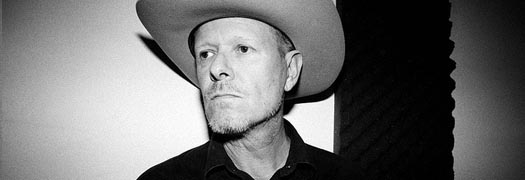
Features | Concerts
Swans
By Andrew Hall | 21 March 2011
Swans’ live show is infamous. Like fellow sonic punishers My Bloody Valentine, Michael Gira’s first and longest-running project developed a reputation from its very first shows, playing single chord dirges at vomit-inducing volumes to the dismay of everyone within a multiple-block radius. I’m too young to have been there, so I only have the band’s substantial collection of live recordings and YouTube videos as reference points. One performance of “A Screw” from 1986 sees Gira, shirtless and howling in front of several percussionists and guitarists bashing their instruments in unison, producing arena-level squalls inside a space nowhere near the size of an arena; it is relentless, all-consuming, apocalyptic. By its final tours, documented best on Swans Are Dead (1998), Gira and then-partner Jarboe dealt in sonic restraint, but never let up their intensity, even as the band itself (and Gira and Jarboe) were imploding. One concertgoer I spoke with who saw one of those final shows described it mostly in terms of the furious looks the two gave each other over the course of the night.
From there, Swans transformed into the more folk-oriented Angels of Light, then found itself “reactivated” for My Father Will Guide Me Up A Rope to the Sky (2010), played by a six-piece ensemble consisting of Gira, Norman Westberg (guitar), Christoph Hahn (steel guitar), Phil Puleo (drums), Chris Pravdica (bass), and Thor Harris (percussion), a combination of long-time associates and recent additions to Gira’s fold. For listeners expecting a return to the Swans of old, the album was likely disarming, as the new songs found plenty of space for the dark folk that Gira made his stock and trade for much of the last ten years, with a handful of concise songs between tense textural builds. However, the band’s set in Seattle in February was one born out of its signature sound. Swans played expansive, body-rattling versions of new and old songs alike, utilizing a shifted instrumental palette to almost-religious effect.
Following Wooden Wand’s fine, if relatively unremarkable opening set (for which he was accompanied by Brad Lowry and Lambchop’s William Tyler, who sounded great and looks startlingly young for being in a band fronted by a man in his fifties), Swans began with an epic crescendo. Harris emerged first, beating pipes with fifteen-pound mallets for what felt like an eternity. The rest of the band came out one by one, building layer upon layer, for upwards of twenty minutes, crafting hypnotic sheets of noise; Gira finally joined the ensemble and led the band into My Father opener “No Words/No Thoughts,” his voice booming atop the all-encompassing wall of sound underneath him.
Despite his players’ proficiency and the strength of the arrangements, Gira was very much the ensemble’s focal point, functioning like a conductor as he gave hand signals to control the long pieces that rose and fell behind him between his sermon-like vocal performances. This was most apparent during Children of God (1987) standout “Sex, God, Sex,” where Gira had the band cut out completely, leaving just his naked voice, bellowing words that wouldn’t have felt entirely out of place in a megachurch. Even at 57, Gira is a remarkable singer. His droning baritone singularly towers above its surroundings, seemingly unworn by decades of heavy use, and it remained utterly arresting.
The band’s set was long—they played for upwards of two hours—but consisted of no more than eight songs, most of which swelled and contracted explosively. Unlike the similarly loud but far more static My Bloody Valentine (who came on loud, then finished louder), Swans wrung power from volume by knowing when to go all-out and when to restrain. The new songs largely did away with the grooves they fall into on the album, with propulsive rhythms cast aside in favor of Puleo and Harris’s thunderous tom hits played almost exclusively in unison. Also, unlike My Bloody Valentine, which limits itself to the basic guitar-bass-drums lineup, the Swans ensemble benefits from the diversity of its instrumentation; Hahn’s pedal steel playing was like nothing I’d ever heard before, cutting through the mix while not once sounding like a traditional steel guitar, and Harris’s hammer dulcimer and mallet work created a set of tones that drifted in and out of having distinct tonal quality.
By its end, I felt like I’d just been subjected to something otherworldly. The reactivated band’s power isn’t the same thing that got it attention in the 1980s, and it’s not the proto-post rock that it pushed at in the 1990s, but elements of both exist within the space the band carves out on stage. Gira is older, obviously, but like a rare handful of musicians he has aged remarkably well, and this tour serves as proof that it’s possible to play extreme music past the age of twenty without looking hopelessly out of place.
It might be easy to assume that given his art, Gira would be a difficult person to approach. After introducing his players toward the end of the set, he pointed to himself and said “Bozo the Clown.” Someone screamed “I love you,” prompting him to simply say “Don’t say that.” Yet on the way out, my friend asked a remarkably personable Gira, speaking to fans at the merch table, if he intended on reviving Angels of Light at any point in the future. He told her no, and that he would be doing Swans until he can’t do it anymore. Here’s hoping that isn’t any time soon.





